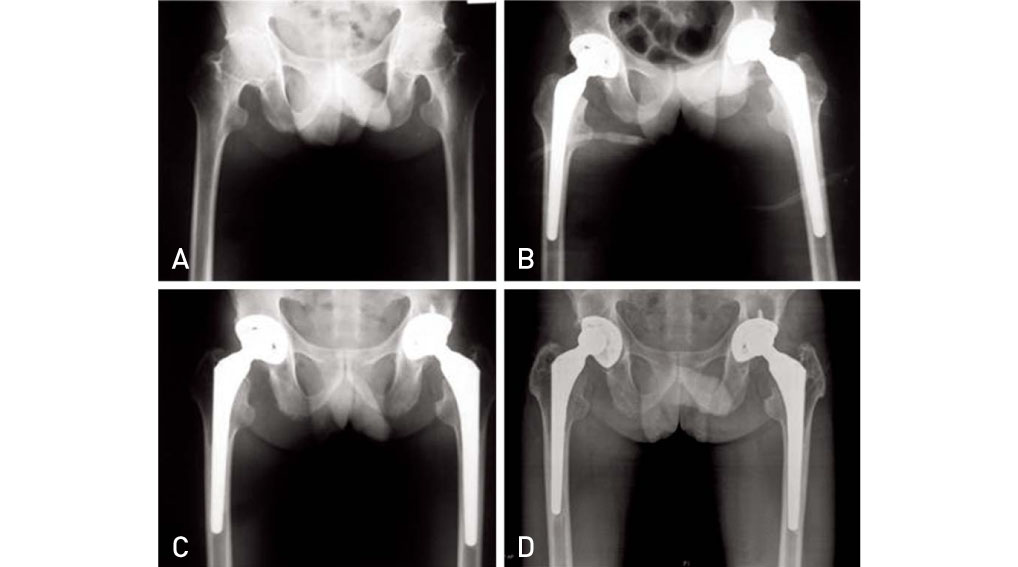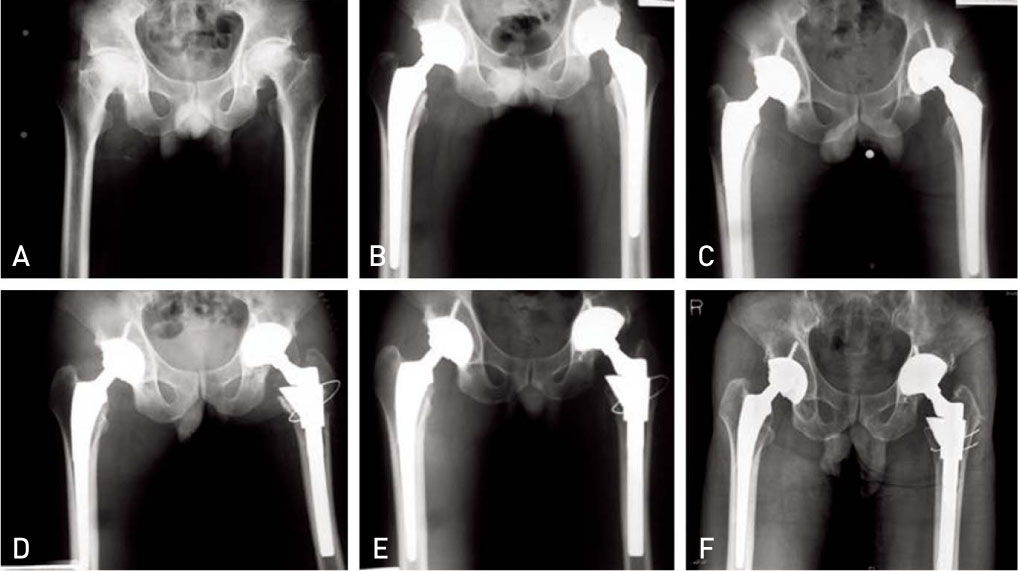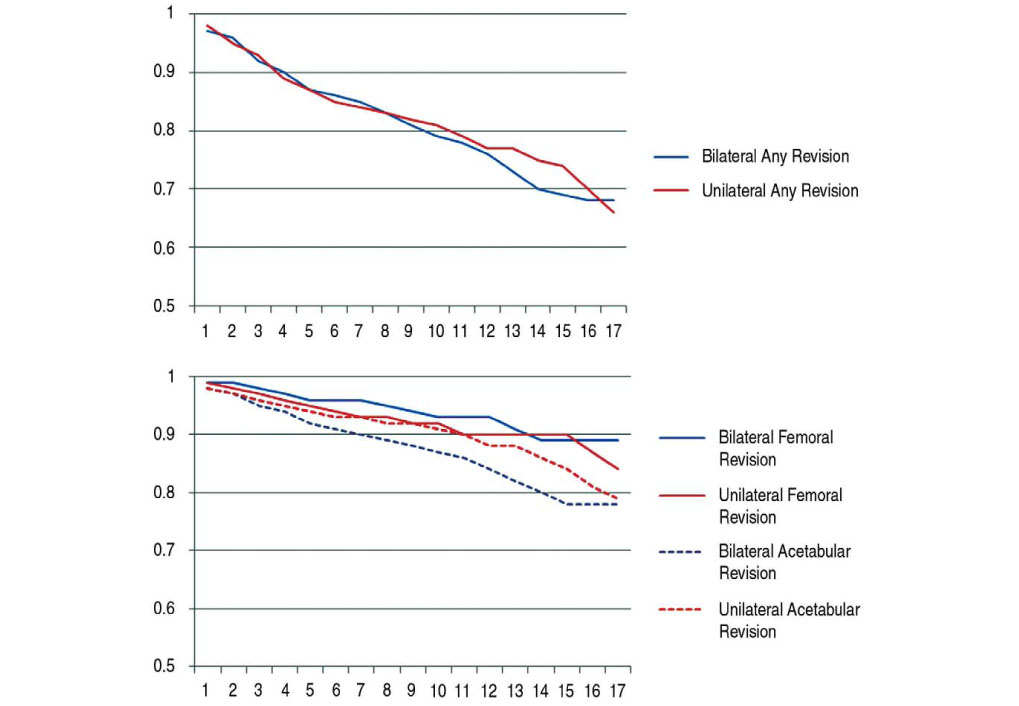Hip Pelvis.
2013 Mar;25(1):21-29. 10.5371/hp.2013.25.1.21.
Simultaneous Bilateral Cementless Total Hip Arthroplasty: a Minimum 17-year Follow-up Study - Comparison Study with Unilateral Cementless Total Hip Arthroplasty -
- Affiliations
-
- 1Department of Orthopedic Surgery, Wonju College of Medicine, Yonsei University, Wonju, Korea. hwtonlka@yonsei.ac.kr
- KMID: 1425032
- DOI: http://doi.org/10.5371/hp.2013.25.1.21
Abstract
- PURPOSE
Long-term follow-up results of concurrent bilateral or unilateral cementless hip arthroplasty were compared.
MATERIALS AND METHODS
Forty eight and 49 patients with concurrent bilateral and unilateral hip artrhoplasties who had more than a 17-year follow-up time were selected. At final follow-up, mean ages were 69.1 and 66.7 years old in the bilateral and unilateral groups, respectively. Mean follow-up times were 21.5 and 22.4 years in the bilateral and unilateral groups, respectively. Clinical results were attained using Harris hip score and standardized anteroposterior and lateral view X-rays.
RESULTS
The bilateral group had mean Harris scores of 44.3(standard deviation 3.78) preoperatively, and 81.2 (10.75) at final follow-up. For the unilateral group, the mean scores were 46.5(3.27) preoperatively, and 80.1 (12.05) at final follow-up. At final follow-up, an acetabular cup was securely located in 78.9% and 82.8% of the bilateral and unilateral groups, respectively, and all cases showed firm fixation of the femoral stem in both groups. Osteolysis around the cup and stem were found in 26.3% and 31.4% of the bilateral group and 16.6% and 17.1% of the unilateral group, respectively. Polyethylene wear rate was 0.17 mm/yr and 0.16 mm/yr in the unilateral and bilateral groups, respectively. Using the Kaplan-Meier method, 17-year survival rates for cup and stem were 78% and 89% in the bilateral group, respectively, and 78% and 86% in the unilateral group, respectively.
CONCLUSION
In 17-year long-term follow-up, concurrent bilateral hip arthroplasty was insignificantly different clinically and radiologically from the result of unilateral hip arthroplasty.
Keyword
Figure
Reference
-
1. Salvati EA, Hughes P, Lachiewicz P. Bilateral total hip-replacement arthroplasty in one stage. J Bone Joint Surg Am. 1978. 60:640–644.
Article2. Otte KS, Husted H, Orsnes T, Kehlet H. Bilateral simultaneous total hip arthroplasty in a fast track setting. Hip Int. 2011. 21:336–339.
Article3. Agins HJ, Salvati EA, Ranawat CS, Wilson PD Jr, Pellicci PM. The nine- to fifteen-year follow-up of one-stage bilateral total hip arthroplasty. Orthop Clin North Am. 1988. 19:517–530.
Article4. Hwang SK, Lee SY. Bilateral cementless total hip arthroplasty: a minimum 5 year comparison study. J Korean Hip Soc. 1999. 11:153–159.5. Hwang SK, Kim HS. One stage bilateral cementless total hip replacement. J Korean Hip Soc. 1992. 4:28–32.6. Alfaro-Adrián J, Bayona F, Rech JA, Murray DW. One- or two-stage bilateral total hip replacement. J Arthroplasty. 1999. 14:439–445.
Article7. Hwang SK, Yi WY. Cementless total hip arthroplasty using AML prosthesis. J Korean Hip Soc. 1993. 5:93–101.8. Schwarzkopf R, Olivieri P, Jaffe WL. Simultaneous bilateral total hip arthroplasty with hydroxyapatite-coated implants: a 20-year follow-up. J Arthroplasty. 2012. 27:1364–1369.
Article9. Engh CA, Bobyn JD, Glassman AH. Porous-coated hip replacement. The factors governing bone ingrowth, stress shielding, and clinical results. J Bone Joint Surg Br. 1987. 69:45–55.
Article10. Engh CA, Glassman AH, Suthers KE. The case for porous-coated hip implants. The femoral side. Clin Orthop Relat Res. 1990. (261):63–81.11. Engh CA, Hooten JP Jr. Porous coating in total hip arthroplasty. Semin Arthroplasty. 1993. 4:248–260.12. Dorr LD, Wan Z, Song M, Ranawat A. Bilateral total hip arthroplasty comparing hydroxyapatite coating to porous-coated fixation. J Arthroplasty. 1998. 13:729–736.
Article13. Callaghan JJ, Dysart SH, Savory CG. The uncemented porous-coated anatomic total hip prosthesis. Two-year results of a prospective consecutive series. J Bone Joint Surg Am. 1988. 70:337–346.
Article14. DeLee JG, Charnley J. Radiological demarcation of cemented sockets in total hip replacement. Clin Orthop Relat Res. 1976. (121):20–32.
Article15. Livermore J, Ilstrup D, Morrey B. Effect of femoral head size on wear of the polyethylene acetabular component. J Bone Joint Surg Am. 1990. 72:518–528.
Article16. Kaplan EL, Meier P. Nonparpmetric estimation from incomplete observation. J Am Stat Assoc. 1958. 53:457–481.17. Ritter MA, Randolph JC. Bilateral total hip arthroplasty: a simultaneous procedure. Acta Orthop Scand. 1976. 47:203–208.
Article18. Ritter MA, Stringer EA. Bilateral total hip arthroplasty: a single procedure. Clin Orthop Relat Res. 1980. (149):185–190.19. Jaffe WL, Charnley J. Bilateral charnley low-friction arthroplasty as a single operative procedure. A report of fifty cases. Bull Hosp Joint Dis. 1971. 32:198–214.20. Shih CH, Ho WB. One-stage versus two-stage bilateral autophor ceramic total hip arthroplasty. Clin Orthop Relat Res. 1985. (193):141–145.
Article21. Cammisa FP Jr, O'Brien SJ, Salvati EA, et al. One-stage bilateral total hip arthroplasty. A prospective study of perioperative morbidity. Orthop Clin North Am. 1988. 19:657–668.22. Egol KA, Lonner JH, Jaffe WL. Simultaneous bilateral total hip arthroplasty with hydroxyapatite coated implants. Bull Hosp Jt Dis. 1998. 57:52–55.23. Loughead JM, O'Connor PA, Charron K, Rorabeck CH, Bourne RB. Twenty-three-year outcome of the porous coated anatomic total hip replacement: a concise follow-up of a previous report. J Bone Joint Surg Am. 2012. 94:151–155.
Article24. Woolson ST, Murphy MG. Wear of the polyethylene of Harris-Galante acetabular components inserted without cement. J Bone Joint Surg Am. 1995. 77:1311–1314.
Article25. Sochart DH, Porter ML. The long-term results of Charnley low-friction arthroplasty in young patients who have congenital dislocation, degenerative osteoarthrosis, or rheumatoid arthritis. J Bone Joint Surg Am. 1997. 79:1599–1617.
Article26. Schmalzried TP, Jasty M, Harris WH. Periprosthetic bone loss in total hip arthroplasty. Polyethylene wear debris and the concept of the effective joint space. J Bone Joint Surg Am. 1992. 74:849–863.
Article27. Bobyn JD, Pilliar RM, Cameron HU, Weatherly GC. The optimum pore size for the fixation of porous-surfaced metal implants by the ingrowth of bone. Clin Orthop Relat Res. 1980. (150):263–270.
Article28. Anseth SD, Pulido PA, Adelson WS, Patil S, Sandwell JC, Colwell CW Jr. Fifteen-year to twenty-year results of cementless Harris-Galante porous femoral and Harris-Galante porous I and II acetabular components. J Arthroplasty. 2010. 25:687–691.
Article
- Full Text Links
- Actions
-
Cited
- CITED
-
- Close
- Share
- Similar articles
-
- Implant Design in Cementless Hip Arthroplasty
- Revision Arthroplasty with Cementless Total Hip Replacement
- Cementless Total Hip Arthroplasty in Long Term Steroid-Induced Avascular Necrosis of the Hip
- Cementless Total Hip Arthroplasty with Use of the COREN Hip System
- Cementless Implant in Total Hip Arthroplasty





